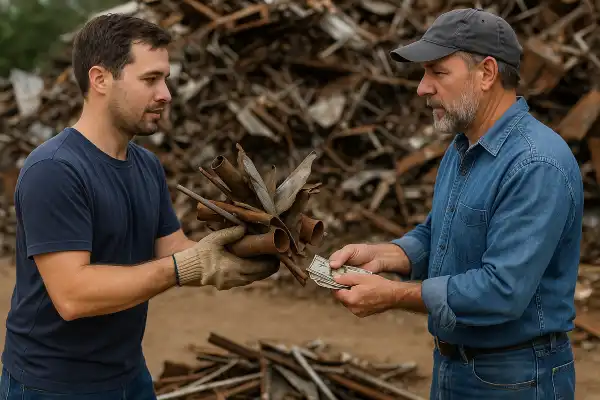How to sell scrap metal remains one of the most frequently asked questions among both industry professionals and homeowners looking to monetize unused materials. The surge in metal recycling interest stems from rising commodity prices and growing environmental consciousness.
During my transition from mechanical engineering to sustainability writing, I discovered that most people drastically undervalue their scrap potential. After years of processing everything from copper piping to industrial steel remnants, I’ve learned that successful scrap selling requires understanding market dynamics, proper preparation techniques, and choosing the right buyers.
My post of the week: Is silver plate worth scrapping?
How to sell scrap metal?
Selling scrap metal effectively requires proper identification, preparation, and choosing reputable buyers. The process involves several critical steps that can significantly impact your final payout.

Identify and categorize your metals
Understanding metal types directly affects your profits. Current market rates show copper fetching $3.45 per pound for #1 grade, while aluminum cans bring approximately $0.68 per pound. The price difference between ferrous and non-ferrous metals can be substantial.
Non-ferrous metals (higher value):
- Copper: Found in electrical wiring, plumbing pipes, and appliance coils. Copper generally sells for higher prices than other scrap metals, with many types valued between $3 and $6 per pound
- Brass: Typically yellowish, found in faucets, valves, and musical instruments
- Aluminum: Common in siding, gutters, cookware, and beverage cans
Ferrous metals (lower value):
- Steel: Found in appliances, construction materials, and automotive parts
- Cast iron: Present in old radiators, cookware, and engine blocks
Use a magnet for quick identification – ferrous metals stick to magnets, while non-ferrous metals don’t.
Prepare materials for maximum value
Proper preparation can significantly increase your payout by removing contaminants and improving metal grades. Clean separation saves time at the yard and demonstrates professionalism.
Cleaning and sorting steps:
- Remove non-metal attachments (plastic, rubber, glass)
- Strip insulation from copper wire when feasible
- Separate different metal types completely
- Clean off dirt, paint, and corrosion where possible
- Group similar grades together
Clean copper can fetch $3-4 per pound, while dirty copper only brings $1-2 per pound. This price difference often justifies the extra preparation time.
Research and choose reputable scrap yards
Finding a reputable, licensed scrap yard ensures fair pricing and legal compliance. Licensed dealers must follow strict regulations regarding identification, record-keeping, and payment methods.
Selection criteria:
- Valid licenses and certifications
- Transparent pricing policies
- Professional equipment (certified scales)
- Good local reputation and reviews
- Clear payment procedures
Call multiple yards to compare prices, as buy rates can vary wildly between facilities. Many yards update prices daily based on commodity markets.
Understand legal requirements and documentation
Scrap metal regulations vary by state and local jurisdiction, with most requiring seller identification and restrictions on certain materials. Compliance protects both buyers and sellers from legal issues.
Common requirements:
- Valid photo identification
- Proof of ownership for valuable metals
- Vehicle registration for transport verification
- Signature on transaction records
Cash payments for scrap metal are illegal under the Scrap Metal Dealers Act 2013. Legitimate yards pay by check or electronic transfer.
Transportation and safety considerations
Safe transport protects you legally and physically. Always wear appropriate protective equipment including gloves and safety glasses, and secure your load properly to prevent items from falling.
Transportation tips:
- Use appropriate vehicle capacity
- Secure loads with straps or chains
- Distribute weight evenly
- Follow local transport regulations
- Consider hiring transport for large quantities
The weighing and payment process
Scrap yards use large, accurate pressure-sensitive plates to weigh your vehicle loaded and unloaded, with the difference determining your scrap total.
Standard procedure:
- Initial weigh-in with loaded vehicle
- Material inspection and sorting verification
- Price negotiation based on current rates
- Unloading and material placement
- Final weigh-out of empty vehicle
- Payment processing (check or electronic)
Market timing and price optimization
Scrap yards’ prices change depending on world supply and demand, with rates potentially changing daily based on economic factors and seasons.
Price optimization strategies:
- Monitor commodity price trends
- Build relationships with multiple buyers
- Consider storage for market timing
- Understand seasonal demand patterns
- Track regional price variations
Maximizing long-term profitability
The real money is in volume handling procedures – processing 50 tons instead of 5 allows better price negotiation with buyers. Consider developing consistent supply sources and building industry relationships.
Business development approaches:
- Establish relationships with contractors and manufacturers
- Develop efficient collection and processing systems
- Invest in basic tools for material preparation
- Learn advanced sorting and grading techniques
- Consider specialization in higher-value materials
Conclusion
Recycling scrap metal is more than reducing waste – it’s a practical way to transform discarded materials into valuable resources. Success requires understanding market dynamics, proper preparation, and choosing ethical business partners.
Just last month, I helped a local contractor properly sort and sell accumulated copper and steel from renovation projects. By investing two hours in proper separation and finding a reputable yard, he increased his return from $200 to nearly $650 for the same materials. The combination of preparation knowledge and market understanding transformed what seemed like industrial waste into meaningful revenue while supporting sustainable practices.
